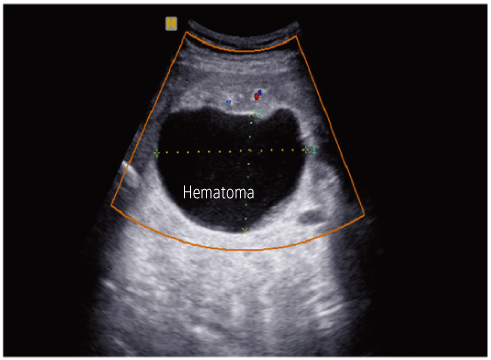Korean J Obstet Gynecol.
2012 Mar;55(3):183-186. 10.5468/KJOG.2012.55.3.183.
A case of ruptured gravid uterus at 35 weeks' gestation after cornual resection
- Affiliations
-
- 1Department of Obstetrics and Gynecology, Soonchunhyang University Cheonan Hospital, University of Soonchunhyang College of Medicine, Cheonan, Korea. drsook@schmc.ac.kr
- KMID: 2274124
- DOI: http://doi.org/10.5468/KJOG.2012.55.3.183
Abstract
- Uterine rupture in pregnancy is a rare condition, but an obstetric emergency. It threatens the life of both the mother and the newborn. Hemorrhage from the wound surface is the principal complication. Therefore, mortality rates strongly depend on the time elapsed between onset and diagnosis of the uterine rupture, and on the possibility of immediate surgical intervention. Prompt diagnosis of the uterine rupture is of prime importance. The major risk factor for uterine rupture is previous cesarean delivery. Other risk factors identified as contributing to uterine rupture are malpresentations, second stage dystocia, labor induction, use of epidural for pain control, preterm delivery and delivery after the 42nd week of gestation. We experienced a woman with a history of corneal resection 1 year ago, who suffered uterine rupture at 35 weeks' gestation during preterm labor.
Keyword
MeSH Terms
Figure
Reference
-
1. Al-Zirqi I, Stray-Pedersen B, Forsén L, Vangen S. Uterine rupture after previous caesarean section. BJOG. 2010. 117:809–820.2. Kaczmarczyk M, Sparén P, Terry P, Cnattingius S. Risk factors for uterine rupture and neonatal consequences of uterine rupture: a population-based study of successive pregnancies in Sweden. BJOG. 2007. 114:1208–1214.3. Ofir K, Sheiner E, Levy A, Katz M, Mazor M. Uterine rupture: risk factors and pregnancy outcome. Am J Obstet Gynecol. 2003. 189:1042–1046.4. Zwart JJ, Richters JM, Ory F, de Vries JI, Bloemenkamp KW, van Roosmalen J. Uterine rupture in The Netherlands: a nationwide population-based cohort study. BJOG. 2009. 116:1069–1078.5. Hamilton EF, Bujold E, McNamara H, Gauthier R, Platt RW. Dystocia among women with symptomatic uterine rupture. Am J Obstet Gynecol. 2001. 184:620–624.6. Ko DY, Lee JH, Kim SH, Kim SR. A case of cornual pregnancy ruptured at 24 week's gestation. Korean J Obstet Gynecol. 2006. 49:2190–2193.7. van Alphen M, van Vugt JM, Hummel P, van Geijn HP. Recurrent uterine rupture diagnosed by ultrasound. Ultrasound Obstet Gynecol. 1995. 5:419–421.8. Turner MJ. Uterine rupture. Best Pract Res Clin Obstet Gynaecol. 2002. 16:69–79.9. Grobman WA, Lai Y, Landon MB, Spong CY, Leveno KJ, Rouse DJ, et al. Prediction of uterine rupture associated with attempted vaginal birth after cesarean delivery. Am J Obstet Gynecol. 2008. 199:30.e1–30.e5.10. Dekker GA, Chan A, Luke CG, Priest K, Riley M, Halliday J, et al. Risk of uterine rupture in Australian women attempting vaginal birth after one prior caesarean section: a retrospective population-based cohort study. BJOG. 2010. 117:1358–1365.11. Cahill AG, Odibo AO, Allsworth JE, Macones GA. Frequent epidural dosing as a marker for impending uterine rupture in patients who attempt vaginal birth after cesarean delivery. Am J Obstet Gynecol. 2010. 202:355.e1–355.e5.12. Confino E, Gleicher N. Conservative surgical management of interstitial pregnancy. Fertil Steril. 1989. 52:600–603.13. Landon MB. Uterine rupture in primigravid women. Obstet Gynecol. 2006. 108:709–710.14. Sagiv R, Golan A, Arbel-Alon S, Glezerman M. Three conservative approaches to treatment of interstitial pregnancy. J Am Assoc Gynecol Laparosc. 2001. 8:154–158.15. Usta IM, Hamdi MA, Musa AA, Nassar AH. Pregnancy outcome in patients with previous uterine rupture. Acta Obstet Gynecol Scand. 2007. 86:172–176.
- Full Text Links
- Actions
-
Cited
- CITED
-
- Close
- Share
- Similar articles
-
- A Case of Ruptured Cornual Pregnancy in Adenomyosis Uterus at 29 Weeks' Gestation
- A case of cornual pregnancy ruptured at 24 week's gestation
- Torsion of a Myomatous Uterus in a Non-Gravid Female: A Case Report
- A case of ipsilateral ruptured cornual pregnancy after salpingectomy for tubal pregnancy: 2-port pelviscopic cornual resection using a multichannel port
- Unruptured Cornual Pregnancy: A Case Report



